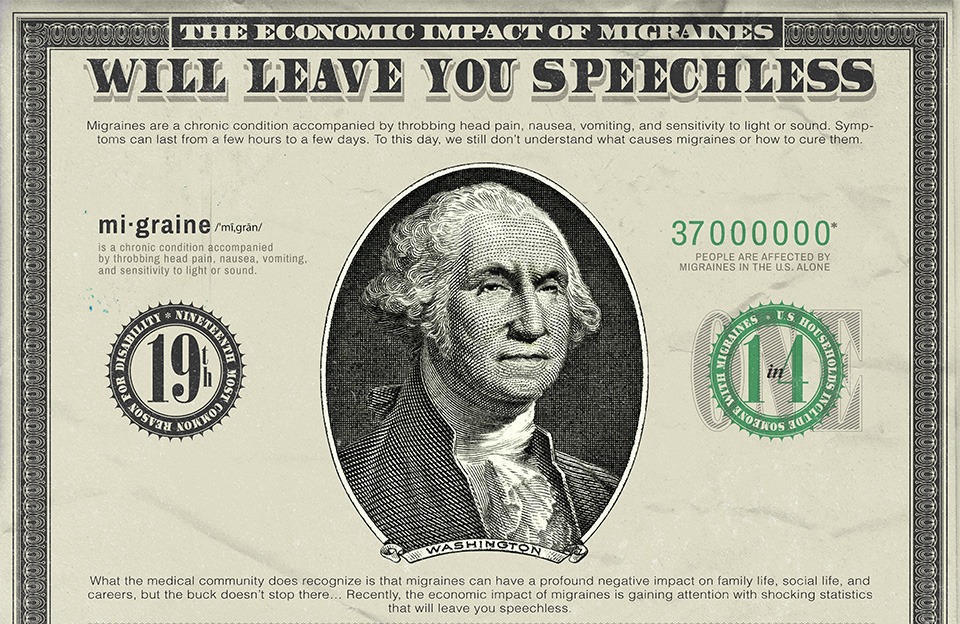Click the image or here to view the entire infographic
Migraines are a chronic condition accompanied by throbbing head pain, nausea, vomiting, and sensitivity to light or sound. Symptoms can last a few hours or a few days and affect nearly 37 million people in America, making the condition the 19th most common reason for disability. Yet, we still don’t understand what causes migraines or how to cure them.
What the medical community does recognize is that migraines can have a profound negative impact on family life, social life, and careers, but the buck doesn’t stop there…more recently, the economic impact of migraines is gaining attention with shocking statistics that will leave you speechless.
Direct vs. Indirect Cost
One study examined whether migraine sufferers incur greater direct (in-patient, out-patient and pharmaceutical services) or indirect (work loss, decreased productivity) cost. Results suggested two-thirds of the financial impact is indirect, meaning employers and insurance companies also take a hit.
Migraines & Productivity
Migraine episodes are most prevalent during an individual’s productive working years (ages 25-55). Of the millions of sufferers:
- 91% miss work or school because they cannot function during an attack.
- 51% that do attend work or school report their productivity levels cut in half.
- 31% missed at least one day of work or school in the past three months.
To put these percentages into perspective: migraines cause nearly 113 million missed days of work or school, 36 million days of bed rest, 21.5 million days of restricted activity and cost $5.6 to $17.2 billion in lost productivity every year!
Migraines & Healthcare
Migraines fall into the chronic illness category, which accrues approximately $50 billion in healthcare costs per year, or 75% of all healthcare outlay (according to the Centers for Disease Control). Migraines can last a lifetime and significantly contribute to healthcare totals in several ways:
- 24% of sufferers will visit the emergency room for severe pain.
- Migraineurs use twice as many prescription drugs as those without migraines to manage pain and symptoms.
- Migraineurs visit doctors and hospitals twice as much as those without migraines.
- Migraineurs require 6x the amount of diagnostic testing to strategize treatment.
It is estimated that the average monthly cost of healthcare for a migraineur is $145 versus $89 per month for non-migraine sufferers and sadly, the cost of treatment can be so high, 47.8% of sufferers avoid medications because they cannot afford them.
Migraines & Mental Health
The Economy is also affected by the side affects associated with migraines. Depression impacts about 25% of sufferers and if untreated, can lead to suicide, the 11th foremost cause of death in America (responsible for 30,000 deaths per year). About 50% of migraineurs also suffer from anxiety, a $42 billion annual economic burden that accounts for nearly one-third of the country’s total mental health bill. These numbers don’t even begin to address the patient’s out of pocket cost for mental health treatment, which can quickly soar into the thousands.
You may also be interested in this article: Migraine Mix Ups: Sinus Headache & Sinus Migraine
The costs and percentages outlined above illustrate what migraine sufferers already know – that migraines are momentous ailments that deserve greater attention. The National Institute of Health (NIH) only generates $15 million per year for migraine research, less than .03% of their total research budget despite migraines being among the top 20 debilitating illnesses in the country. To reduce economic impact and restore quality of life, more funding is required to better understand what causes migraines and how they can be better treated or cured.
Image Source: Adhere Creative


